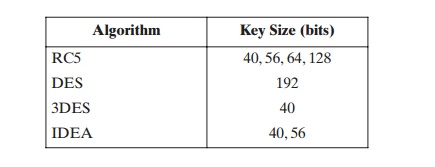Chapter:
Wireless Transport Layer Security
WIRELESS
TRANSPORT LAYER SECURITY
WTLS provides security
services between the mobile device (client) and the WAP gateway. WTLS is based on the
industry-standard Transport Layer
Security (TLS) Protocol,3 which is a refinement of the Secure
Sockets Layer (SSL)
protocol. TLS is the
standard security protocol
used between Web browsers
and Web servers. WTLS is
more efficient that TLS, requiring fewer message exchanges. To provide
end-to- end security, WTLS is used between the client and the gateway,
and TLS is used between the gateway and the target server (Figure 17.14). WAP systems translate between WTLS and TLS
within the WAP gateway. Thus,
the gateway is a point of
vulnerability and must be given a high level of security from external attacks.
WTLS provides the following features.
•
Data integrity: Uses message
authentication to ensure
that data sent between
the client and the gateway
are not modified.
•
Privacy: Uses encryption to ensure that
the data cannot
be read by a third
party.
•
Authentication: Uses digital certificates to authenticate the
two parties.
•
Denial-of-service protection: Detects and rejects messages
that are replayed or not successfully verified.
WTLS Sessions and Connections
Two important WTLS concepts are the secure
session and the secure connection, which are defined in the specification as:
•
Secure connection: A connection is a transport (in the OSI
layering model def- inition) that provides a suitable type of service.
For SSL, such connections are peer-to-peer relationships. The connections are transient. Every connection is associated with one session.
•
Secure session: An SSL
session is an association between
a client and
a server. Sessions are created by the Handshake
Protocol. Sessions define a set of cryp- tographic security parameters, which
can be shared among multiple connec- tions. Sessions are used to avoid the
expensive negotiation of new security parameters for each connection.
Between any pair of parties
(applications such as HTTP on client and server),
there may be multiple secure connections. In theory, there may also be multiple
simultaneous sessions between
parties, but this feature is not used in practice.
There are a number of states associated with
each session. Once a session is established, there is a current operating state
for both read and write (i.e., receive and send). In addition, during the
Handshake Protocol, pending read and write states are created. Upon successful
conclusion of the Handshake Protocol, the pending states become the current
states.
A session state is defined by the following
parameters:
•
Session identifier: An arbitrary byte sequence chosen
by the server to identify an active or resumable
session state.
•
Protocol version: WTLS
protocol version number.
•
Peer certificate: Certificate of the peer.
This element of the state
may be null.
•
Compression
method: The algorithm used to compress data prior to encryption.
•
Cipher
spec: Specifies the bulk data encryption algorithm (such as
null, RC5, DES, etc.) and a hash algorithm (such as MD5 or SHA-1)
used for MAC calculation. It also defines cryptographic attributes such as the hash_size.
•
Master secret: A 20-byte
secret shared between
the client and
server.
•
Sequence number: Which sequence numbering scheme (off, implicit, or explicit) is used in this secure connection.
•
Key refresh: Defines how
often some connection state values (encryption key, MAC secret, and IV) calculations are performed.
•
Is resumable: A flag indicating whether
the session can be used to initiate
new connections.
The connection state is the operating environment of the
record protocol. It includes all parameters that are needed for the
cryptographic operations (encryp- tion/decryption and MAC
calculation/verification). Each secure connection has a connection state, which
is defined by the following parameters.
•
Connection end: Whether this entity is considered a client or a server in this secure session.
•
Bulk cipher algorithm: Includes the key size of this algorithm, how much of that
key is secret, whether it is a block or stream cipher,
and the block
size of the cipher (if appropriate).
•
MAC algorithm: Includes
the size of the key used for MAC calculation
and the size of the hash which is returned by the MAC algorithm.
•
Compression algorithm: Includes all
information the algorithm requires to do compression.
•
Master secret: A 20-byte
secret shared between
the client and
server.
•
Client random: A 16-byte value
provided by the client.
•
Server random: A 16-byte
value provided by the server.
•
Sequence
number mode: Which scheme is used to communicate
sequence numbers in this secure
connection.
•
Key refresh: Defines how
often some connection state parameters (encryption key, MAC secret, and
IV) are updated. New keys are calculated
at every n = 2key_refresh messages, that is, when the sequence
number is 0, 2n, 3n, etc.
WTLS Protocol
Architecture
WTLS is not a single protocol but rather two
layers of protocols, as illustrated in Figure
17.15. The WTLS Record
Protocol provides basic
security services to various
higher-layer protocols. In particular, the Hypertext Transfer Protocol (HTTP),
which provides the transfer service
for Web client/server interaction, can operate on top of
WTLS. Three higher-layer protocols are
defined as part of WTLS:
the Handshake Protocol, The
Change Cipher Spec Protocol, and the Alert Protocol. These WTLS-specific
protocols are used in the management of WTLS exchanges and are examined subsequently in this section.
WTLS RECORD PROTOCOL The WTLS Record Protocol takes user data
from the next higher layer (WTP, WTLS Handshake Protocol, WTLS Alert Protocol,
and WTLS Change Cipher Spec Protocol) and encapsulates these data in a PDU. The
following steps occur (Figure 17.16).

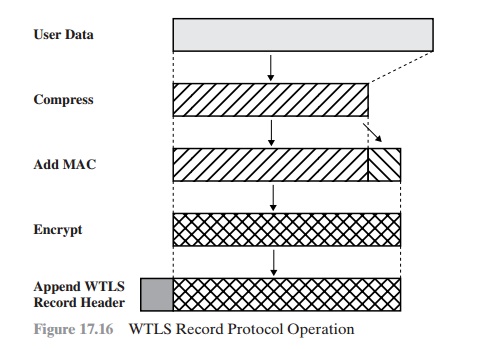
Step
1. The
payload is compressed using a lossless compression algorithm.
Step
2. A message authentication code (MAC) is computed over the compressed data, using HMAC. One of several
hash algorithms can be used with HMAC, including
MD-5 and SHA-1.
The length of the hash code is 0, 5, or 10 bytes. The MAC is added after the compressed data.
Step 3. The compressed message plus the MAC code are
encrypted using a symmetric encryption algorithm. The allowable encryption algorithms are DES, triple
DES, RC5, and IDEA.
Step
4. The
Record Protocol prepends a header to the encrypted payload.
The Record Protocol header consists of the
following fields (Figure 17.17).
•
Record type (8
bits): Consisting of the subfields:
–Record length
field indicator (1 bit): Indicates whether a record
length field is present.
–Sequence number field indicator (1 bit): Indicates
whether a sequence number field is
present.
–Cipher spec indicator (1 bit): If this bit is zero, it indicates that no compression, MAC protection, or encryption is used.
–Content
type (4 bits): The higher-layer protocol above the WTLS Record Protocol.
•
Sequence number (16 bits):
A sequence number
associated with this record.
This provides reliability over an unreliable transport service.
•
Record length (16 bits):
The length in bytes
of the plaintext data (or compressed data if compression is used).
CHANGE CIPHER SPEC PROTOCOL Associated with the current transaction is a
cipher spec, which specifies the encryption algorithm, the hash algorithm
used as
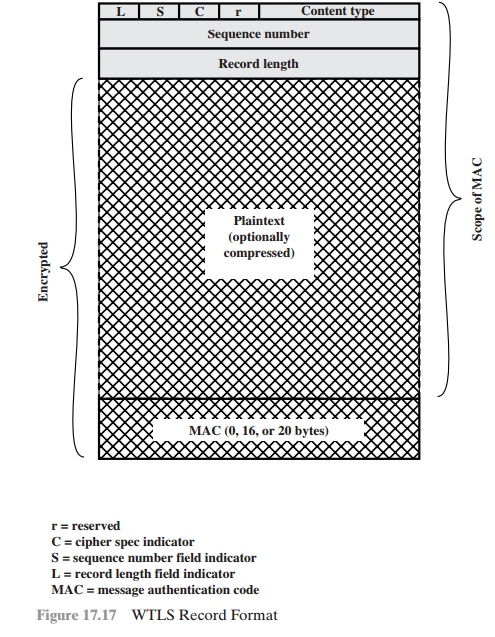
part of HMAC, and cryptographic attributes,
such as MAC code size. There are two states associated with each session. Once
a session is established, there is a current operating state for both read and
write (i.e., receive and send). In addition, during the Handshake Protocol,
pending read and write states are
created.
The Change Cipher Spec Protocol
is one of the three
WTLS-specific protocols that use the WTLS Record Protocol,
and it is the simplest.
This protocol consists
of a single message,
which consists of a single
byte with the value 1. The sole purpose
of this message is to cause
the pending state
to be copied into the current state,
which updates the cipher
suite to be used on this connection. Thus, when the Change Cipher Spec message arrives,
the sender of the message
sets the current
write state to the pending state and the receiver sets the current
read state to the pending
state.
ALERT PROTOCOL The Alert Protocol is used to convey
WTLS-related alerts to the peer entity. As with other applications that use
WTLS, alert messages are compressed and encrypted, as specified by the current
state.
Each message in this protocol
consists of 2 bytes. The first byte takes the value warning(1), critical(2), or fatal(3)
to convey the severity of the message.
The second byte contains a code that indicates the specific alert. If the level is fatal,
WTLS immediately terminates the connection. Other
connections on the same session
may continue, but no new connections on this session
may be established. A critical
alert message results in termination of the current
secure connection. Other connections
using the secure session may continue and the secure identifier may also be used for establishing new secure connections.
The connection is closed using
the alert messages. Either
party may initiate
the exchange of the
closing messages.
If a closing message is received, then
any data after this message is ignored.
It is also required that the notified
party verifies termination of the session by responding to the closing
message.
Error handling in the WTLS is based on the alert messages.
When an error is detected, the
detecting party sends an alert message containing the occurred error. Further
procedures depend on the level of the error that occurred.
Examples of fatal alerts:
•
session_close_notify: notifies
the recipient that the sender will not
send any more messages
using this connection state or the
secure session.
•
unexpected_message: An inappropriate message was received.
•
bad_record_mac: An
incorrect MAC was received.
•
decompression_failure:
The decompression
function received improper input (e.g., unable to decompress
or decompress to greater than
maximum allowable length).
•
handshake_failure: Sender was
unable to negotiate an acceptable set
of security parameters given
the options available.
•
illegal_parameter: A field
in a handshake message was
out of range
or inconsistent with other
fields.
Examples of nonfatal alerts:
•
connection_close_notify: Notifies the recipient that the sender
will not send any more messages
using this connection state.
•
bad_certificate: A received
certificate was corrupt
(e.g., contained a sig- nature that did not verify).
•
unsupported_certificate: The type of the received certificate is not supported.
•
certificate_revoked: A certificate has been revoked
by its signer.
•
certificate_expired: A certificate has expired.
•
certificate_unknown: Some
other unspecified issue arose in processing the certificate, rendering it unacceptable.
HANDSHAKE PROTOCOL The most complex part
of WTLS is the Handshake Protocol. This protocol allows the server
and client to authenticate each other and to
negotiate an encryption and MAC algorithms and cryptographic keys to be used to protect
data sent in a WTLS
record. The Handshake Protocol is used before
any application data are transmitted. An important function of the Handshake Protocol is the generation of a
pre-master secret, which in turn is used to generate
a master secret. The master secret is then used to generate various cryptographic keys.
The Handshake Protocol consists of a series of messages
exchanged by client and server. Figure 17.18 shows the initial exchange needed
to establish a logical
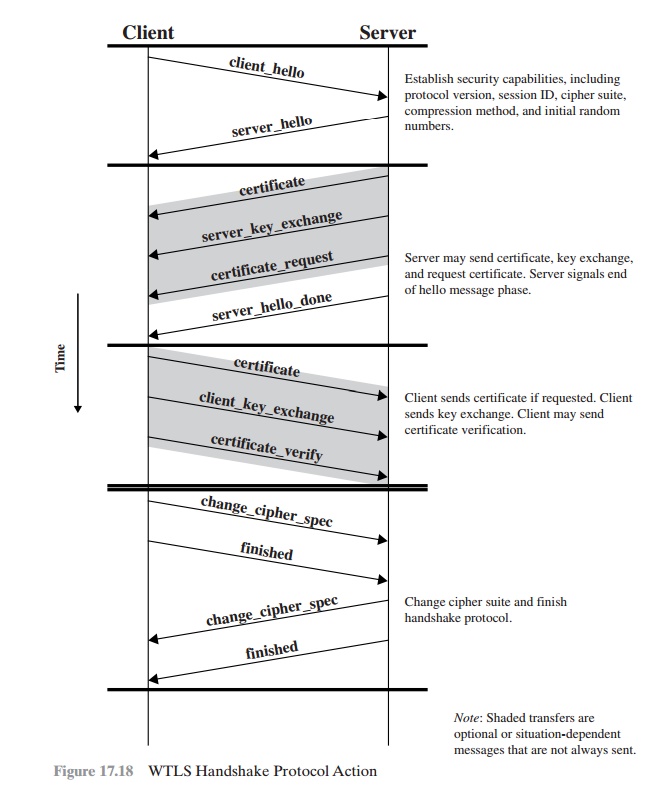
connection between client and server. The exchange can be viewed as having four phases.
The first
phase is used to initiate a logical connection and to establish the
security capabilities that will be associated with it. The exchange is initiated by the
client. The client sends a client_hello message that includes a session ID and a list of cryptographic
and compression algorithms supported by
the client (in decreasing order of preference for each algorithm
type). After sending the client_hello message, the client waits
for the server_hello message. This message indicates which
cryptographic and compression algorithms will be used for the exchange.
The second
phase is used for server authentication and key exchange. The server begins this phase by sending
its public-key certificate if it needs to be authenticated.
Next, a server_key_exchange message may
be sent if it is required.
This message
is needed for certain public-key algorithms used for
symmetric key exchange. Next, the server can request a public-key
certificate from the client, using
the certificate_request message. The final message
in phase 2 (and one that is
always required) is the server_hello_done message,
which is sent by the server to indicate the end of the server hello and
associated messages. After sending this message, the server will wait for a
client response. This message has no parameters.
The third
phase is used for client authentication and key exchange. Upon receipt of the server_hello_done
message, the client should verify that the server
provided a valid certificate if required and check that the server_hello parameters are acceptable. If all is satisfactory, the
client sends one or more mes- sages back to the server. If the server has
requested a certificate, the client sends a certificate message. Next is the client_key_exchange message,
which must be sent in this phase. The content
of the message depends on the type of key exchange. Finally, in this phase, the client may send a certificate_verify message to pro-
vide explicit verification of a client certificate.
The fourth phase completes the setting up of a secure connection. The client sends a change_cipher_spec message and copies
the pending
CipherSpec into the current CipherSpec. Note that this
message is not considered part of
the Handshake
Protocol but is sent
using the Change Cipher Spec Protocol.
The client then immediately sends the finished
message under the new algorithms, keys, and
secrets. The finished message verifies
that the key exchange and authentication
processes were successful. In response
to these two messages, the server sends its own change_cipher_spec message, transfers
the pending to the current
CipherSpec, and sends its finished message. At this point, the hand- shake is complete, and the client and server
may begin to exchange application
layer data.
Cryptographic
Algorithms
AUTHENTICATION Authentication in
the WTLS is carried out with certificates. Authentication can occur either between the client and the server or when the client only
authenticates the server. The latter procedure can happen only if the server
allows it to occur.
The server can require
the client to authenticate itself
to the server.
However, the WTLS specification defines that
authentication is an optional procedure. Currently, X.509v3, X9.68, and WTLS
certificates are supported. The WTLS certificate is optimized for size, and
consists of the following elements (compare
with Figure 14.14).
•
Certificate_version: Version of the certificate.
•
Signature_algorithm: Algorithm used to sign the certificate.
•
Issuer: Defines the party who has signed the certificate, usually some CA.
•
Valid_not_before: The beginning of validity period
of the certificate.
•
Valid_not_after: The point of time after
the certificate is no longer
valid.
•
Subject: Owner of the key, associated with the public key being certified.
•
Public_key_type: Type (algorithm) of the
public key.
•
Parameter_specifier: Specifies parameter relevant for the public key.
•
Public key: The public key being
certified.
•
Signature: Signed with the CA’s private
key.
KEY
EXCHANGE The purpose of the WTLS
protocol is for the client and server to generate a mutually shared pre-master key. This key is then used to generate as
master key, as explained
subsequently. A number of key exchange protocols are supported by WTLS.
They can
be grouped into those protocols that include a server_key_exchange message as
part of the Handshake Protocol (Figure 17.18)
and those that don’t.
The server_key_exchange message is sent by the server only when the
server certificate message
(if sent) does not contain
enough data to allow the client
to exchange a pre-master secret.
The following three methods
require the use of the server_key_exchange message.
•
DH_anon:
The conventional
Diffie-Hellman computation is performed
anonymously (without authentication). The
negotiated key (Z) is used as the pre_master_secret.
•
ECDH_anon: The
elliptic curve Diffie-Hellman computation is performed. The negotiated key
(Z) is used
as the pre_master_secret.
•
RSA_anon: This is an RSA key exchange without
authentication. The server
sends its RSA public key. In this
method, a 20-byte secret value is generated by the client, encrypted under the server’s
public key, and sent to the
server. The server uses its private key to decrypt
the secret value. The pre_master_secret is the secret value appended with the server’s public key.
The server key exchange message is not sent for the following
key exchange methods.
ECDH_ECDSA: Elliptic curve Diffie-Hellman key exchange with ECDSA-
based certificates. The server sends
a certificate that contains
its ECDH public key. The server certificate is signed with
ECDSA by a third party trusted by the client. Depending
whether the client is to be authenticated or not, it sends its certificate containing
its ECDH public key signed with ECDSA by a third party trusted by the server or
just its (temporary) ECDH public key. Each party calculates the pre-master
secret based on one’s own private key and counterpart’s public key received as
such or contained in a certificate.
•
RSA: RSA
key exchange with RSA-based certificates.
The server sends a certificate that
contains its RSA public key. The
server certificate is signed with RSA by
a third party trusted by
the client. The client extracts the server’s
public key from the received certificate, generates a secret value, encrypts it with the server’s
public key, and sends it to the
server. The pre- master secret is the secret value appended with the server’s
public key. If the client is to be authenticated, it signs some data (messages sent during the handshake) with its RSA private key and sends its certificate
and the signed data.
PSEUDORANDOM FUNCTION(PRF) The PRF is used for
a number of purposes in WTLS. The
PRF takes as input a secret value, a seed, and an identifying label and produces
an output of arbitrary length. In the TLS standard, two hash algorithms were used in
order to make the PRF as secure
as possible. In order to save resources, WTLS can be implemented
using only one hash algorithm. Which
hash algorithm is actually
used is agreed on during
the handshake as a part of the cipher
spec.
The PRF is based on the data expansion
function
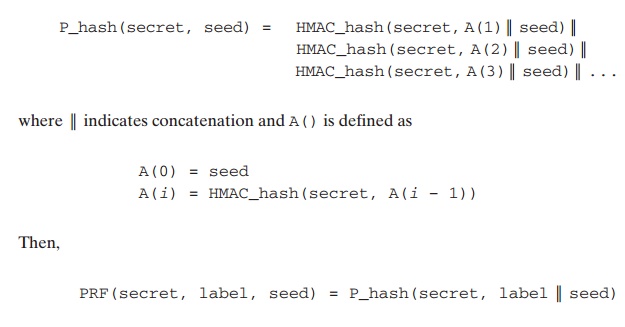
MASTER KEY
GENERATION The
shared master secret is a one-time 20-byte value (160
bits) generated for this session by
means of secure key exchange.The
creation is in two stages. First, a pre_master_secret is exchanged. Second, the master_secret
is calculated
by both parties, using
the function
master_secret = PRF(pre_master_secret,
"master secret", ClientHello.random | ServerHello.random)
where ClientHello.random and ServerHello.random are the random numbers
exchanged during the first phase of the handshake protocol.
The MAC and encryption keys are then derived
from the master key. The MAC calculation uses the HMAC algorithm (Chapter 12)
and encompasses the fields indicated in the expression
HMAC_hash (MAC_secret, seq_number | WTLSCompressed.
record_type|| WTLSCompressed.length | WTLS Compressed.fragment)
where WTLSCompressed.fragment refers to the (optionally) compressed plain- text data field.
Either MD5 or SHA-1 may be used for the HMAC
hash function.
Encryption is applied to all of the WTLS
record, except the header. The following encryption algorithms are permitted.
